I used to think dining chairs had to match perfectly. Then I discovered the magic of mixing different styles around one table. Now my dining room has so much more personality, and I saved money too!
If you’re tired of cookie-cutter dining sets or want to refresh your space without buying everything new, mismatched dining chairs might be your answer.
This trend isn’t just about throwing random chairs together; there’s a simple method that makes it work every time.
I’ll show you exactly how to create a cohesive look that feels intentional, not chaotic.
What are Mismatched Dining Chairs?
Mismatched dining chairs are a styling method that involves combining different chair styles, colors, or materials around a single dining table.
This creates visual depth and personality in your dining space. Instead of buying a complete matching set, you mix and match individual chairs that share at least one common element.
Why it works:
- Adds character and visual interest
- Budget-friendly approach to dining room design
- Easy to update as your style evolves
- Creates a collected-over-time look
How to start: Pick one unifying element, such as color, material, silhouette, or cushion fabric, and then vary 1-2 other details.
The 3-Step Formula
Here’s my foolproof method for mismatched dining chairs:
- Anchor Pair: Start with 2 matching chairs as your foundation
- Cohesive Link: Add chairs that share a finish, upholstery, or material
- One Wild Card: Include one chair with a different shape or bold color for interest
This formula prevents your dining area from looking random while still achieving that curated, personal feel.
Key Benefits of Dining Table with Mismatched Chairs
Mixing different chair styles around your dining table offers practical advantages beyond just looking good. Here’s why this trend makes sense for both your space and your wallet.
| Benefit | What It Means |
|---|---|
| Personality & Warmth | Your dining room feels lived-in and personal, avoiding the sterile look of a fully matched set. |
| Budget Flexibility | Thrift single chairs, blend vintage with new, or build the set over time to spread costs. |
| Easy Upgrades | Swap just one chair to refresh the whole room without starting over. |
| Space-Smart Solutions | Mix sizes and styles to suit room constraints and your family’s seating needs. |
Dining Table With Different Chairs: Ideas You Can’t Miss
Ready to create your own mismatched chair masterpiece? These proven combinations show you exactly how to mix different styles while maintaining that all-important visual connection.
1. Same Color, Different Shapes

Use chairs in a single color family, but vary the silhouettes for an instant touch of sophistication.
Try all-black chairs in different styles, including a traditional spindle-back, a sleek modern shell chair, and an upholstered dining chair with button tufting.
The unified color makes the different shapes feel intentional rather than random. This approach works beautifully with any color: try all white for a fresh look, or deep navy for drama.
2. Mixed Materials: Wood + Metal + Upholstered
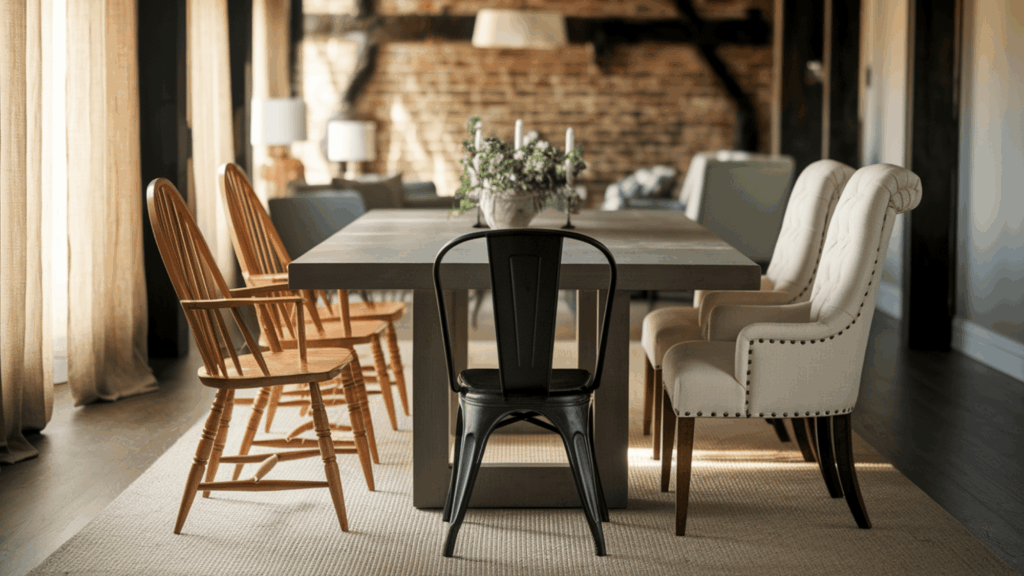
Combine a classic wooden Windsor chair, a black metal bistro chair, and a cream upholstered chair for the perfect material mix.
The variety adds wonderful texture and visual interest while the neutral tones keep everything cohesive.
This combination works especially well in transitional homes where you want both warmth and modern edge. The key is balancing the visual weight of each material.
3. Two-by-Two Pairs + One Accent Head Chair
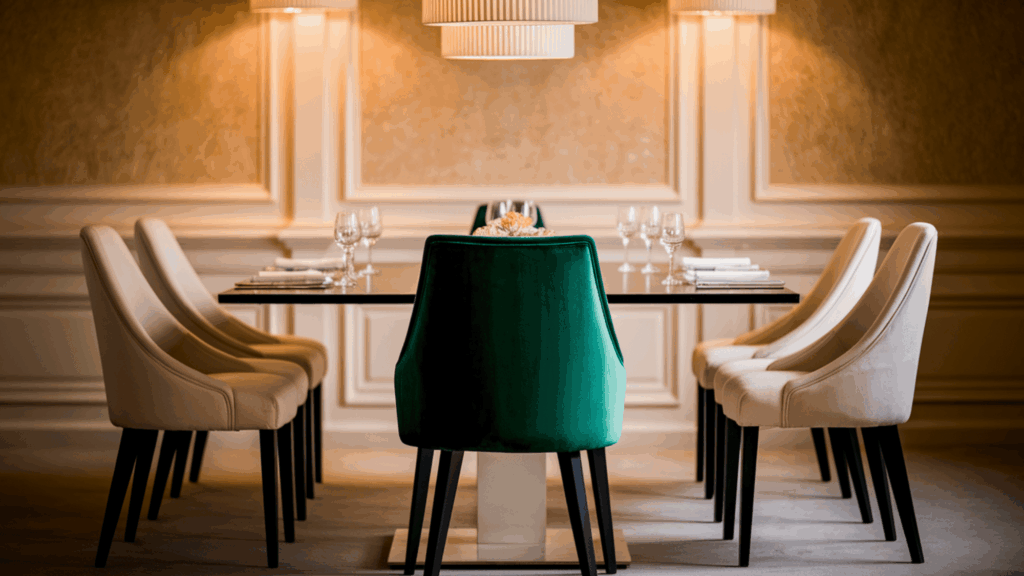
Use two matching chairs on each long side of a rectangular table, then add a bold accent chair at the head position.
This creates perfect symmetry while allowing for personality at the focal point.
It works especially well for families who need one “grown-up” chair for the head of household, or when you want to highlight a vintage find or statement piece.
4. Monochrome Neutrals with Rich Textures
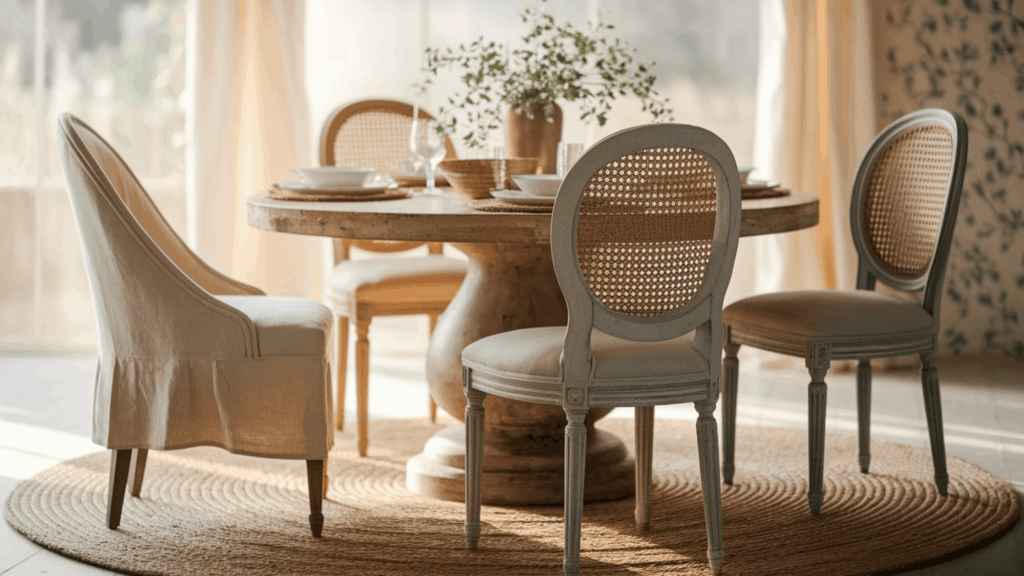
Mix cream, beige, and white chairs in different textures, soft linen upholstery, natural cane backs, and painted wood finishes.
The neutral palette creates a serene foundation while varied textures add depth and visual interest. This approach feels fresh and collected, perfect for creating a calming dining environment.
Layer in natural elements, such as a jute rug, to enhance the organic feel.
5. Vintage + Modern Blend
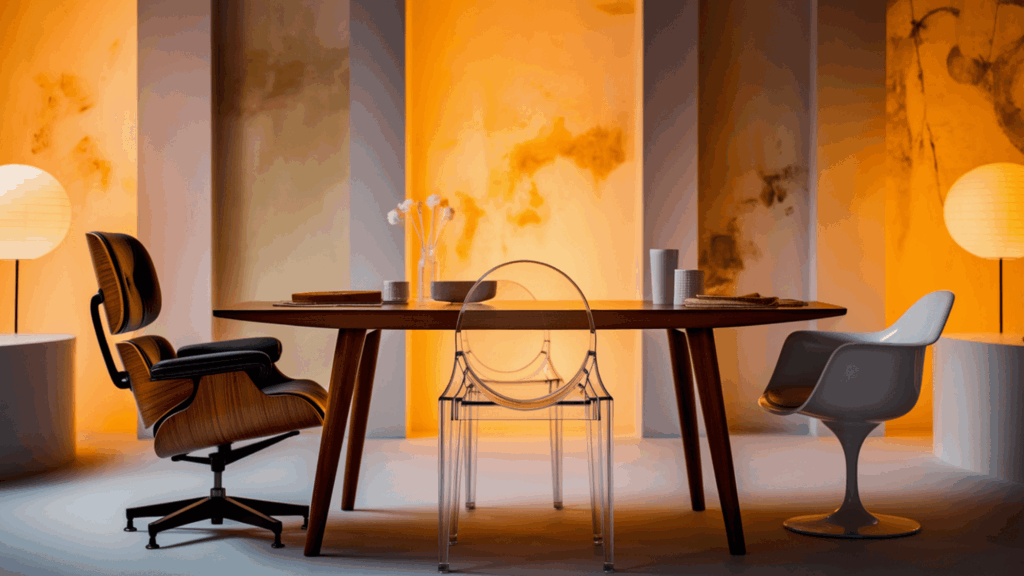
Pair authentic mid-century modern chairs with sleek contemporary pieces for an eclectic yet sophisticated look.
A vintage Eames-style molded chair looks stunning next to a clear acrylic chair when both share similar proportions and seat heights.
This mix celebrates design history while feeling current. Focus on complementary shapes and maintain consistent spacing for the best visual impact.
6. Color Pop on One Chair
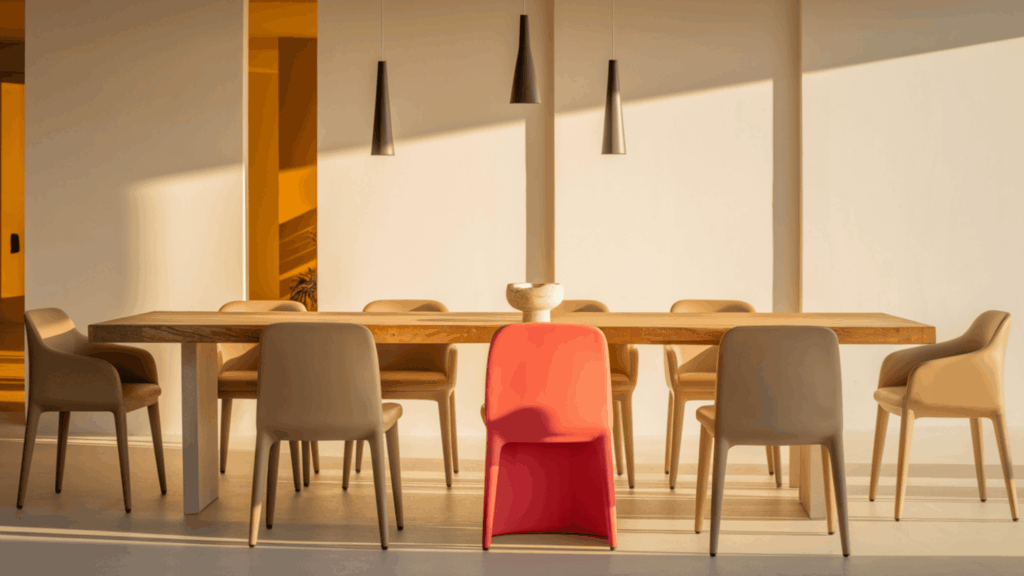
Keep most chairs in neutral tones, then add one vibrant chair as your statement piece and conversation starter.
Choose a bold color like emerald green, coral, or sunny yellow that complements your room’s palette.
This strategy works perfectly if you like to refresh your decor seasonally. Simply swap out the colorful chair for an instant room makeover without major expense.
7. Pattern Play
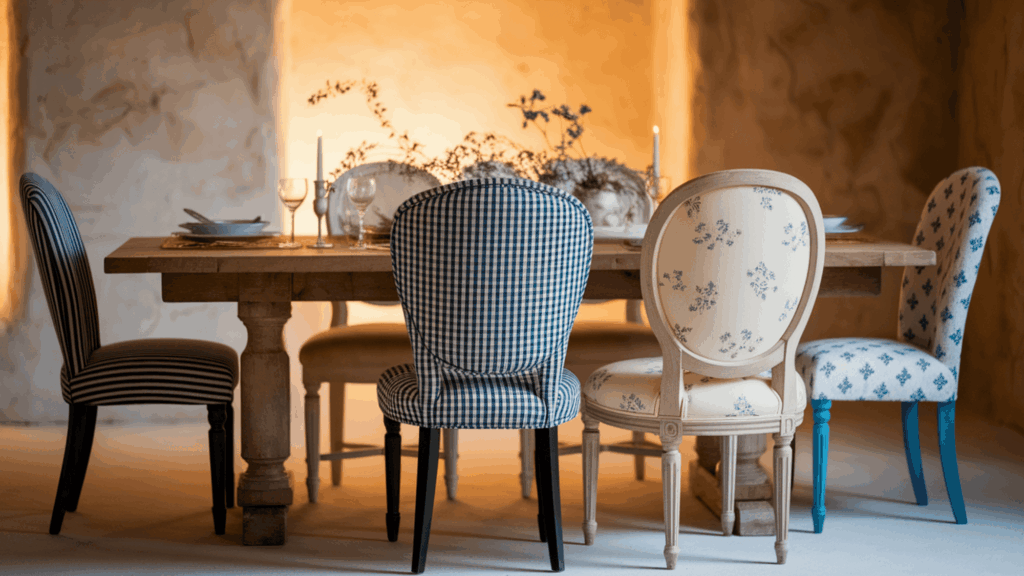
Mix complementary patterns, such as thin stripes, small checks, and delicate florals, but keep the background colors within the same family for cohesion.
Stick to 2-3 patterns maximum to avoid overwhelming your dining space. This approach adds personality and visual interest while maintaining a classy tone.
Consider varying the scale of patterns; pair a large check with a small stripe for dynamic contrast.
8. Coastal Light Woods + Woven Seats
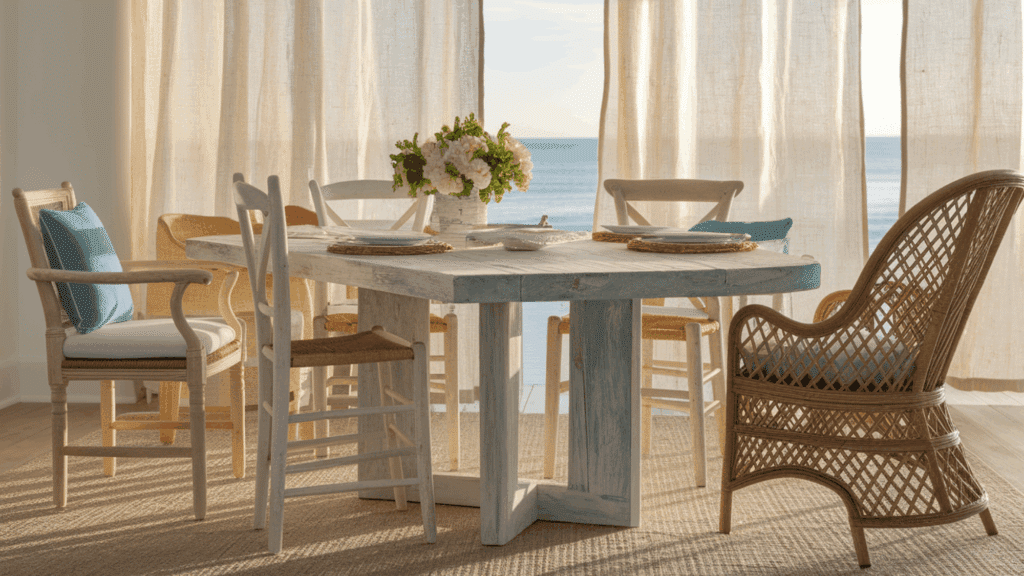
Combine light oak, bleached pine, and natural rattan chairs for a relaxed coastal dining vibe that feels effortlessly elegant.
The natural materials and light finishes create a perfect harmony, despite the different chair styles and origins. Add white or blue seat cushions to tie the look together.
This combination works beautifully in beach houses, sunrooms, or any space craving organic texture.
9. Industrial Metal Mix with Wood Top
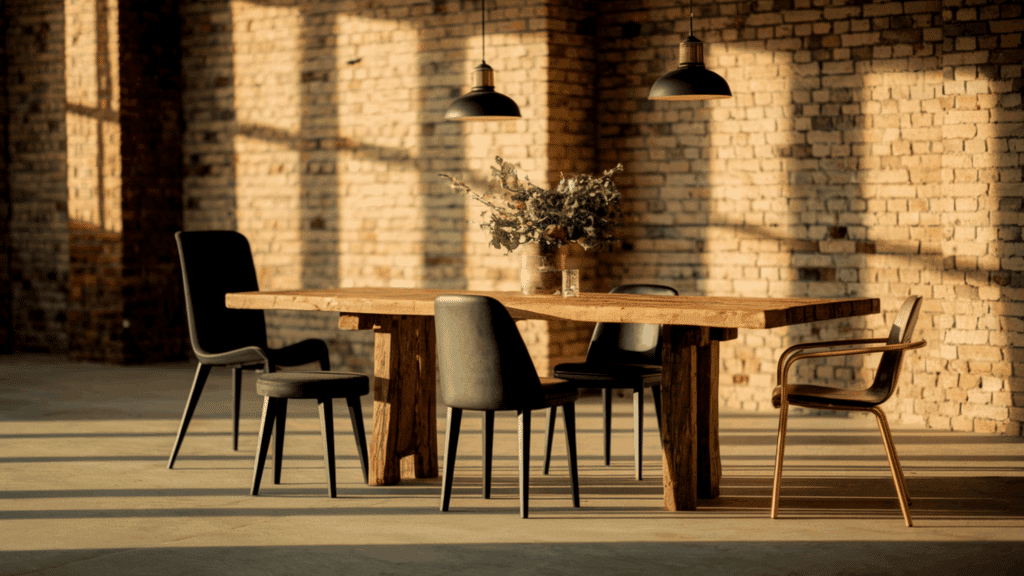
Use different metal chairs, some with high backs, some backless stools, some in matte black, others in warm brass, around a rustic reclaimed wood table.
The metal connection unifies the mix while different finishes add depth.
This combination works perfectly in loft spaces, modern farmhouse kitchens, or anywhere you want that perfect blend of raw and refined industrial-chic elements.
10. Scandinavian Soft Curves + Minimal Palette
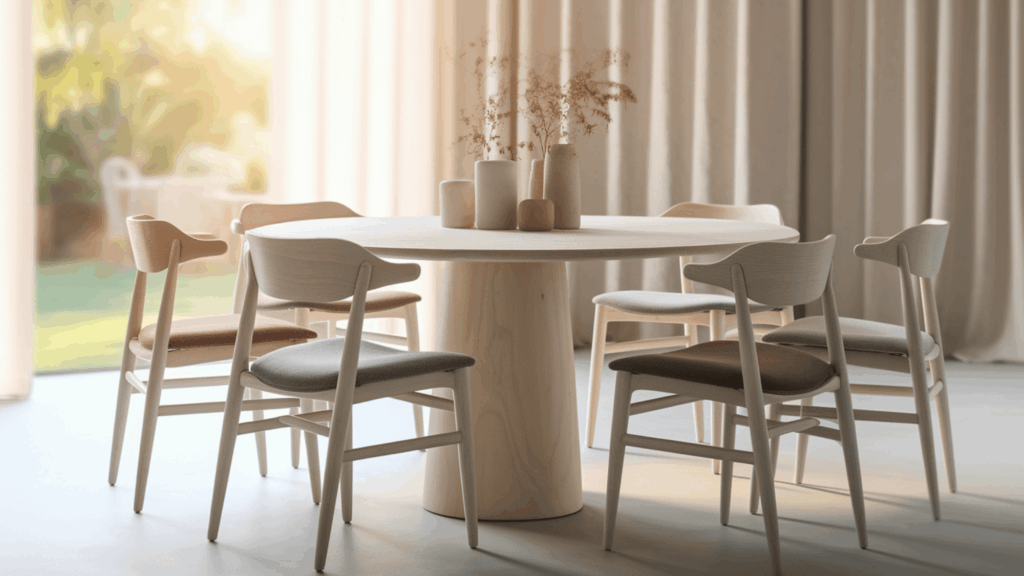
Choose chairs with gentle curved lines in light ash, birch, or painted wood, keeping colors soft and muted.
Even completely different chair styles feel cohesive when they share those gentle, rounded Scandinavian design elements. Add simple linen cushions in off-white or pale gray.
This approach creates a serene, hygge-inspired dining space that feels both modern and timeless.
11. Farmhouse Crossbacks + Painted Spindle Chairs
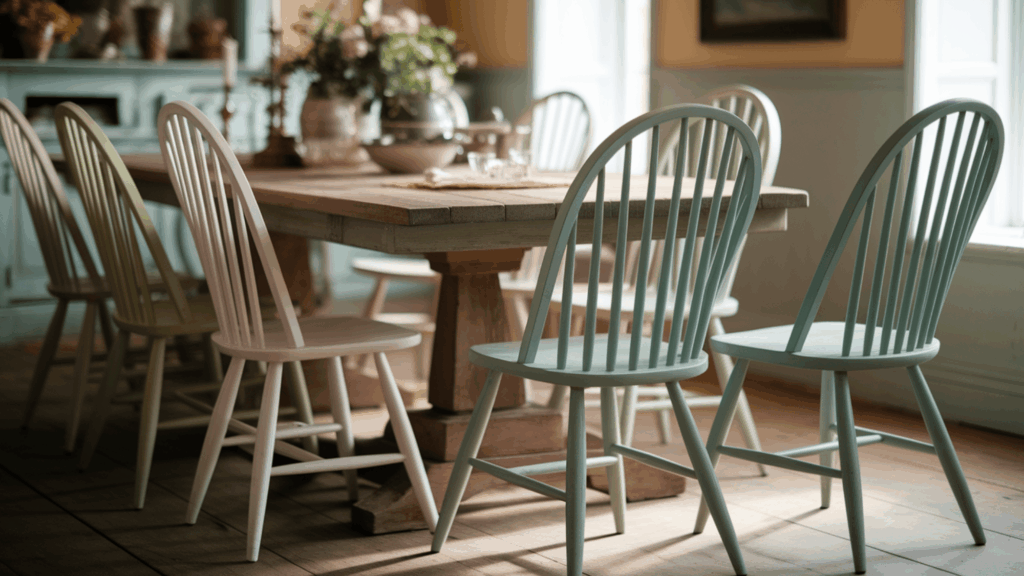
Mix traditional farmhouse chair styles in coordinating paint colors for authentic country charm with personality.
Try white and sage green crossback chairs paired with matching painted Windsor spindles, or combine cream and soft blue tones.
The shared paint treatment and traditional silhouettes create cottage charm, while the color variation adds visual interest and prevents the look from feeling too matchy-matchy.
Pro Tip: Repeat one element in at least three chairs to make your mismatched set feel intentional rather than random.
Sizing, Balance & Proportions
To create a balanced dining area, follow these key design principles for sizing, balance, and proportion.
| Design Element | Guideline | Why it Works |
| Table & Chair Match | Pair heavy tables with sturdy chairs (e.g., Windsor, upholstered). Match delicate tables with lighter chairs (e.g., bentwood, wire). | Creates a unified look and prevents visual imbalance. |
| Arm Chairs vs. Armless | A mix of armchairs at the ends and armless chairs on the sides offers a balanced arrangement. | Maximizes seating space while maintaining a visually appealing setup. |
| Table Leg Type | Choose a pedestal table for flexible chair placement. For four-legged tables, ensure chairs fit and are easy to move. | Prevents chairs from hitting table legs, improving flow and function. |
| Rug Sizing | The rug should extend at least 24 inches beyond the table’s edge on all sides. | Keeps all chair legs on the rug when pulled out, preventing snags and protecting your floor. |
By applying these straightforward rules, you can design a dining space that is both stylish and highly functional.
Common Mistakes to Avoid
These mistakes might make your mismatched dining look cluttered:
- Too Many Variables at Once: Avoid mixing color, material, shape, and pattern in a single set. Pick 1-2 elements to vary while keeping others consistent.
- Ignoring Comfort and Function: Ensure that seat heights are suitable for your table and that the chairs provide adequate support. Beauty shouldn’t sacrifice comfort.
- No Repeating Elements: Without any common thread, your chairs will look random rather than curated. Always repeat something across at least half your chairs.
- Overcrowding Your Table: Allow at least 24 inches of space per person around the perimeter of your table. Tight spacing makes different chair styles feel chaotic.
Final Thoughts
Mismatched dining chairs allow you to create a dining space that reflects your personal style. I prefer a simple three-step approach: anchor pair, cohesive link, and one wildcard.
The best rooms tell a story, and mixing chairs shows how your style grows over time. The trick is balancing variety with unity.
I aim for a contrast that feels lively, along with consistency that feels calm. When you nail that sweet spot, the room feels curated yet comfortable, just what every home needs. Ready to begin?
Choose one unifying element, such as a wood tone, metal finish, color, or fabric, and then hunt for pieces that speak to you. I swap slowly, edit often, and trust my eye.














